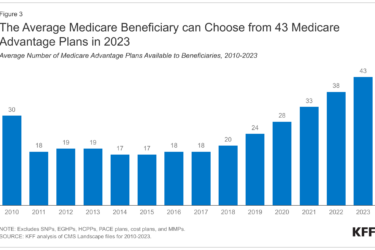
From the future of delivery system reform to controlling prescription drug costs to considering how states may handle proposed Medicaid cuts, there is significant concern these days among policy experts who focus on aging and health. Several of the addressed the issue at a recent panel in New York City on the future of aging policy under the Trump administration.
Developing a national aging strategy was high on the list for participants of the session, “Aging Priorities for a New Administration,” part of the d.health Summit 2017 on May 10. Moderating was Joanne Kenen, health care executive editor at Politico and AHCJ’s topic leader on Health Policy.

Public policies should incorporate the holistic nature of aging, focusing on person-centered, not just patient-centered care, according to Robert Blancato, chairman of the American Society on Aging and national coordinator of the Elder Justice Coalition. Proposed budget reductions to Medicaid and community-based services are particularly concerning, he said. “Cost cuts all the issues around independence, well-being, good health. We need a policy direction that aims us somewhere, that has an outcome associated with it.”

Proposed changes in health care premiums for adults who are not yet Medicare eligible were particularly alarming, said Lina Walker, vice president of health security at the AARP Public Policy Institute.
About half of all Medicare beneficiaries have incomes under $26,000 per year, and individuals age 60 to 64 who buy into the individual insurance market have a median income of around $20,000 annually, according to Walker. If the approach taken in House bill gains more traction in the Senate, many people who have a pre-existing medical condition will be less able to afford premiums due to proposed premiums increases for older, less healthy purchasers.

Older adults who rely on Medicaid as well as Medicare, known as dual-eligibles, also will be hit hard. “For the first time, we’re talking about taking an entitlement and saying let’s cap that amount, and also take nearly a trillion dollars out of the system,” said Rima Cohen, managing director of The Aspen Institute and former counselor for health policy to the secretary at the Department of Health and Human Services.
While some defend this approach and claim the poor elderly, disabled, or high-needs children won’t be touched, “You can’t just save that kind of money from capping services to healthier kids,” Kenen said. The bulk of Medicaid money – nearly two-thirds – goes to care for older, sicker, or disabled individuals.
Huge budget cuts mean states will have to put more funds into their Medicaid programs, but it is unclear where many financially strapped governors will find the money, Walker said. They may opt for provider, service or benefit cuts that would hurt many successful home- and community-based programs. Alternatively, they could impose waiting lists and restrict who can access those services.
“This is really moving us backward, not forward, not where people want to be, at home and in their community,” she said, adding that the cuts would hurt the very people who should have access to the care and services they need.

David Thompson, J.D., general counsel and vice president of strategy for the medical technology consulting company Grand Rounds, thinks more work is needed on the state level to drive quality improvement programs. These may be ACO-type programs, or dynamic networks of providers who specialize in particular types of elder care, providing the right team for the situation. Reimbursement would be based on value and outcomes.
Panelists agreed that new reforms that integrate new payment initiatives, care delivery strategies and improve quality, while lowering cost, are necessary. There is broad bipartisan support for this approach, but getting these ideas into a new health bill could prove challenging. “This is really a multi-stakeholder effort, and the stakes are pretty high,” Cohen noted.
I asked the panel to talk about prescription drug prices, which impact so many areas of care.
Blancato thinks the outcry over drug pricing has grown louder, even on the Hill. “The question has become whether the industry does more of its own policing within its ranks and make some changes, or whether we get a real bipartisan hard push on drug reform,” he said.
“I suspect we’re not far from that now,” he predicted. “It’s on the radar screen much higher than it was even a few years ago.”
Cohen pointed out that drug price negotiation is an extraordinarily complex situation. The industry is highly regulated, with multiple considerations affecting pricing, and many different formularies with various price structures.
“We need to figure out what makes sense,” she said.
Another concern is the hesitation by physicians, insurers and other private sector players to invest in long-term programs aimed at improving outcomes and reducing costs over time. Programs with high upfront costs — such as tobacco cessation, diabetes management or alcohol management — may not show desired outcomes or cost-savings for several years. Few stakeholders want to take on such efforts, given the uncertainty in Washington.

Do legislators have the ability to come together on a bipartisan basis to support innovative elder-focused community programs? Kenen pointed out that there are people in Congress and the Trump administration who understand these issues. Many understand that integrating social and medical needs help to connect the dots, in which we can’t do one without the other. While it may take time, she is somewhat optimistic that, eventually, we will get the needed bipartisan support to develop health policies benefitting older adults.
Resources
- More AHCJ coverage of these issues here, here, and here.
- Additional coverage of the AHCA and impact on older individuals from The Atlantic, Consumer Reports, Next Avenue/Forbes, The Washington Post.
- This article from The Hill on lobbying groups to watch.










